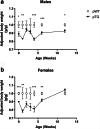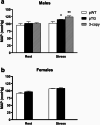Fetal Renal DNA Methylation and Developmental Programming of Stress-Induced Hypertension in Growth-Restricted Male Mice
- PMID: 32046425
- PMCID: PMC7539823
- DOI: 10.1007/s43032-019-00121-5
Fetal Renal DNA Methylation and Developmental Programming of Stress-Induced Hypertension in Growth-Restricted Male Mice
Abstract
Fetal growth restriction (FGR) is associated with developmental programming of adult onset hypertension, which may be related to differences in nephron development. Prior studies showed that maternal nutrient restriction is associated with reduced nephrogenesis in rodents, especially in male progeny. We hypothesized that maternal genetic risk for FGR may similarly affect fetal kidney development, leading to adult onset hypertension. We employed an angiotensinogen (AGT) gene titration transgenic (TG) construct with 3 copies of the mouse AGT gene that mimics a common human genotype (AGT A[-6]G) associated with FGR. We investigated whether FGR in 2-copy (wild type, [WT]) progeny from 3-copy TG dams leads to developmental programming differences in kidney development and adult blood pressure compared with age- and sex-matched controls. Progeny were tested in the late fetal period (e17.5), neonatal period (2 weeks of age), and as young adults (12 weeks). We measured weights, tested for renal oxidative stress, compared renal DNA methylation profiles, counted the number of glomeruli, and measured adult blood pressure ± stress. Progeny from TG dams were growth restricted with evidence of renal oxidative stress, males showed fetal renal DNA hypermethylation, they had fewer glomeruli, and they developed stress-induced hypertension as adults. Their female siblings did not share this pathology and instead resembled progeny from WT dams. Surprisingly, glomerular counts in the neonatal period were not different between sexes or maternal genotypes. In turn, we suspect that differences in fetal renal DNA methylation may affect the long-term viability of glomeruli, rather than reducing nephrogenesis.
Keywords: Angiotensinogen; DNA methylation; Developmental programming; Hypertension; Nephrogenesis.
Conflict of interest statement
The authors declare that they have no conflict of interest.
Figures





References
-
- Mi J, Law C, Zhang KL, Osmond C, Stein C, Barker D. Effects of infant birthweight and maternal body mass index in pregnancy on components of the insulin resistance syndrome in China. Ann Intern Med. 2000;132:253–260. - PubMed
Publication types
MeSH terms
Grants and funding
LinkOut - more resources
Full Text Sources
Medical
Miscellaneous

